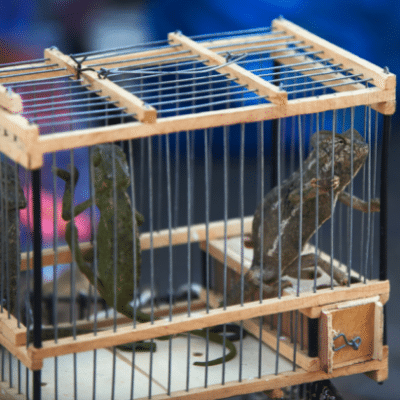How to Move with Snakes and Reptiles
Is your family planning a cross-country move and you’re not sure how to move with snakes and reptiles pets? Maybe you just bought a new house? Or perhaps you finally found the perfect apartment to rent in the next city over? No matter what the motivation, you’ll most definitely be planning to bring your scaley pets along!
Moving with reptiles and other exotic pets can be a challenge. Unlike with a cat or a dog (both of which can easily be loaded into the backseat of a car) travelling with snakes and reptiles requires a little more planning.
Today’s amazing blog post brings in animal experts to share everything you need to know to make your reptilian friend’s move easy as 1, 2, 3.
Let’s dive in!
How to Transport and Move with Snakes and Reptiles
Did you know? According to statistics from A Report on Reptile Pet Ownership in The United States, approximately 4.5 million American households own a reptile. Of that, many are snakes. The most popular species include ball pythons, corn snakes, king snakes, and milk snakes.
So naturally, when people choose to relocate to a new place, one of the first questions they ask is, “How do you travel with a pet snake?”
Here are some easy-to-implement tips to ensure a stress free move:

Use a Separate Enclosure to Move with Snakes and Reptiles
Start by preparing a different enclosure to contain your snake during car rides. Don’t keep them in their normal cage or terrarium, instead you’ll want to be a bit more carful in the way you move with snakes and reptiles.
Remember, snakes are escape artists! If their regular glass container falls and shatters into sharp pieces, not only could they escape in the car (uh oh) but they could also potentially injure themselves.
Similarly, bumpy roads can knock off lids. Your safest bet is to use a plastic storage container with small holes poked in the top. For more specific tips on how to transport your pet reptile, consult a local pet store expert.
Remember, moving your pets is stressful not only for you, but also your reptile or amphibian. Taking special care to pack your reptile while maintaining the transportation environment as close to their natural habitat as possible will go a long way.
Restrict Feeding for 2 – 3 Days
Secondly, those planning to move with snakes should avoid feeding their pet immediately beforehand. Believe it or not, snakes can get carsick. Undigested food in their stomach can be regurgitated if they become too stressed.
This is a health risk and it is a good idea to hold back a meal until they are settled in their new home. Timing your pets food and water intake will help make the whole transition much easier.


Be Mindful of the Heat when Moving with Snakes and Reptiles
Lastly, be very careful of over or underheating your snake. Generally speaking, most snakes enjoy temperatures between 70 – 90 degrees Fahrenheit.
However, when traveling with a snake, it becomes impossible to keep their usual heat lamps and lighting plugged in.
A snake who gets a chill will act sluggishly. Left in cold temperatures for too long, and they can catch hypothermia and die. The same can be said for all reptiles.
Likewise, leaving a snake in a hot car in direct sunlight is also dangerous. They could burn, get a fever, suffer neurological damage, etc.
Therefore, always think ahead! Bedding, handwarmers, hot water bottles can help keep a snake warm. Air conditioning will cool them down.
Should you need to travel for a longer period of time, consider trying the disposable heat and cold packs sold by Reptile Express.
5 Easy Ways to Keep Calm As You Move with Snakes and Reptiles
Travelling with snakes is fairly common, but all reptiles require some brainstorming to make their move go as smoothly as possible. Whether you have an iguana, gecko, bearded dragon, or tortoise, here are 5 tips to keep a reptile relaxed on moving day.
1. Get Your Reptile Accustomed to a Travel Carrier
Practice loading and unloading at home. Give your reptile time to enter their travel carrier/container without being rushed or forced. This will help them feel safe when the day of the big move comes.
2. Prepare the Temporary Enclosure
This tip might seem obvious, but it’s worth repeating. Add whatever your reptile requires before putting them inside the enclosure. Bedding/substrate should be done first.
3. Drive VERY Carefully
Alright, you’re both ready to hit the road! Take it easy on the corners, slowly roll up to red stoplights, and don’t slam on the brakes. You are transporting precious cargo, so be careful.
4. Use a Seatbelt
Buckle up. Just like us humans, reptiles must be securely fastened inside a vehicle. This prevents their enclosures from slipping and sliding all over the place. If your buckles won’t fit around the container, the next best option is to place it on the floor.
5. Monitor and Check Frequently
Finally, keep an eye on your reptile. A short drive from one location to the next that only takes fifteen minutes is unlikely to cause any worries. However, the longer the trip, the more frequently you should check in on how they are doing. Watch for signs of stress.
And never leave a reptile alone in a car. By following these 5 handy tips, reptile parents are setting themselves up for guaranteed moving success. Now, you know exactly how to move with snakes and reptiles!



